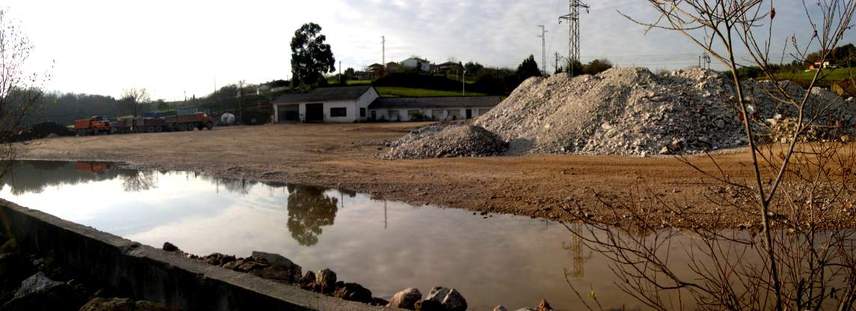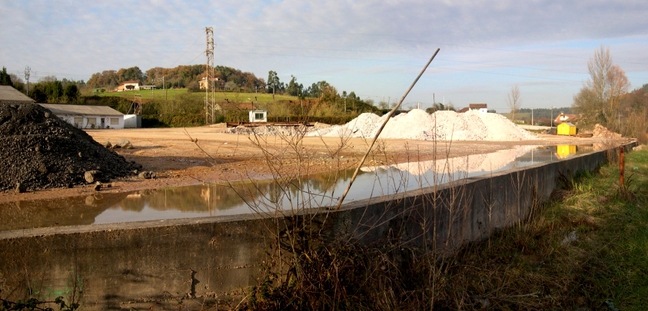Villabona mining area, Asturias, Spaini
| Regional Level Types | |
|---|---|
| Villabona mining area | Mining Area |
| Asturias | Autonomous Community |
| Spain | Group of Countries |
This page is currently not sponsored. Click here to sponsor this page.
Latitude & Longitude:
43° North , 5° West (est.)
Estimate based on other nearby localities or region boundaries.
Margin of Error:
~121km
Type:
Mindat Locality ID:
68767
Long-form identifier:
mindat:1:2:68767:1
GUID (UUID V4):
23a0fc5e-faf8-42a2-b1b4-6cf71b7b0a24
Name(s) in local language(s):
Zona Minera de Villabona, Asturias, España
Villabona-Arlós district (SW border of Asturian Permo-Triassic basin) includes several epigenetic stratiform fluorite deposits, often related with vein deposits in fractures.
These stratiform formations are located within a carbonate formation equivalent to "Brecha Roja" ("conglomerado de la Riera").
The mineralization lithostratigraphy is as follows:
- Sand/clay/conglomerates lower formation (Buntsandstein or Permian)
- Sandy limestones (3-6 meter thick) with stratiform fluorite deposits
- Sandstones, pelites and conglomerates (Buntsandstein or Permian)
- Clays with gypsum (Keuper)
Two generations of fluorite are known : An early one (18-22 % salinity) and a late one, in vugs (0-8 % salinity and lower temperature).
Temperature and salinity are similar for the stratiform and the veins in the same deposit.
K+/Na+ gradient decreases from east to west (Cucona-Villabona to Arlós) and from north to south (Gloria-Moscona to Arlós)
Temperature and salinity decrease from east to west and from north to south.
Reductive conditions decrease from east to west (pposition in the basin).
A first low-T (80-90 °C) and high-salinity circulation (ascendant hydrothermal waters rich in K and F of volcanic origin) mixed with a lower T (60-70 °C) and lower salinity superficial water circulation (descendant meteoritic circulation in a lateral geothermic gradient).
-----------------------------------------------------------------
The Villabona-Arlós mining area is geographically located in the municipalities of Llanera and Corvera, Asturias. The mining peak for this area began with coal mining and in fact all the fluorspar mines that operated in this area are inside old concessions demarcated for the exploitation of this fossil fuel.
The first historical references about the existence of fluorite in this area were provided by Máximo Fuertes Acevedo in 1884 when he said in his book on Asturian fluorite: “The fluorine lies on the Jurassic limestone formation becoming a quite important vein in the village of Ferroñes belonging to the municipality of Llanera. This vein is next to the Santo Firme coal formation, between Oviedo and Avilés, filling with thick crystals the pockets formed in the siliceous puddingstone”.
The concessions on which are the deposits are found began to be demarcated from the year 1830 ((Nº 15 “Peña del Águila”; Nº 40 “Vena del Medio”, Nº 79 “Santa Bárbara”). A little later, in 1859, the emblematic concessions Rafaela and Ricarda (Nº 102 and 109) were demarcated. It was, however, much later, in 1935, when the first attempt to exploit fluor spar took place.
The Spanish Civil War in 1936 put paid to these first mining trials. From 1945, the locals who lived in Mundín, a hamlet very close to Villabona, taking advantage of the fact that the fluorite vein was visible on the surface, mined it on an irregular basis. Thus, José Luis Menéndez, aka “El Trina”, as well as José Valdés, an employee of RENFE (the Spanish Railway Network), managed to extract several thousands of tons of fluor spar from this deposit, shipping them for sale to several national foundries from the Villabona Railway Station itself. This irregular nature was plain: regardless of fact that the land, where the mineral was mined, belonged to the first party, the rights to mine the subsoil had been granted by the mining agency to the company Minas de Villabona who at the time were dedicated to coal mining. In 1955 this mining company began legal action for this reason, which was ruled in its favor in 1965 and from this date they operated both coal and fluorite mines.
Nowadays all the concessions belonging to Minas de Villabona who are in turn owned by Preminor, who also own the treatment plant located at the mouth of the mine.
Within La Vega, a village close to Villabona, Fernando Pendás Álvarez demarcated three concessions for fluorite between 1944 and 1945, among which was one known as “Cucona” nº 25.271. In 1946 the company González y Díaz adcquired these concessions for the extraction of fluorite as well as coal. During two decades this company mined them intermittently and finally sold the concessions to Minersa in 1972. From this date to 1992, this company operated the deposit extracting fluorite and introducing innovative concepts for the time such as the method of chambers and pillars, but adding the novelties of the use of trucks running on inclined planes and using combustion engines.
In parallel with the development of the Villabona area, the works in Arlós area were initiated by S.I.A. Santa Bárbara Company within the concession “Pepito” with its corresponding 7 enlargements. It was sold to “Minas de Arlós” which exploited it until its closure in 1980.
The only and more productive mine now active is the Moscona Mine located in the municipality of Corvera de Asturias, owned by the Minersa Company.
In all the mines the fluorite is predominantly yellow, commonly associated with baryte, calcite, pyrite, chalcopyrite, dolomite and rarely marcasite, quartz, magnetite, sphalerite, galena, cinnabar, copper carbonates, aurichalcite, anglesite, gypsum and tetrahedrite.
The fluorite crystals display a cubic habit usually measuring up to 2 cm on edge, which is a typical feature of the whole mineralization of this area, although in the Villabona area crystals up to 7 cm. have been very found rarely. Frequently in Moscona the crystals display deeper yellow fluorescence near their edges.
Pyrite is more common in the Villabona area, while baryte occurs with the mineral more frequently in Moscona-Arlós area. The calcite is equally distributed in both areas, although the habits vary widely in each one.
Select Mineral List Type
Standard Detailed Gallery Strunz Chemical ElementsCommodity List
This is a list of exploitable or exploited mineral commodities recorded from this region.Mineral List
Mineral list contains entries from the region specified including sub-localities16 valid minerals.
Rock Types Recorded
Note: data is currently VERY limited. Please bear with us while we work towards adding this information!
Rock list contains entries from the region specified including sub-localities
Select Rock List Type
Alphabetical List Tree DiagramDetailed Mineral List:
| ⓘ Anglesite Formula: PbSO4 |
| ⓘ Aurichalcite Formula: (Zn,Cu)5(CO3)2(OH)6 |
| ⓘ Azurite Formula: Cu3(CO3)2(OH)2 |
| ⓘ Baryte Formula: BaSO4 Localities: Description: The barite is associated with fluorite, as tabular crystals up to 5 cm in size, usually blue (rarely yellow), translucent and bright. References: |
| ⓘ Calcite Formula: CaCO3 Localities: References: |
| ⓘ Chalcopyrite Formula: CuFeS2 Localities: |
| ⓘ Cinnabar Formula: HgS |
| ⓘ Dolomite Formula: CaMg(CO3)2 |
| ⓘ Fluorite Formula: CaF2 Localities: Description: Fluorite appears in this location as large clusters of cubic crystals, honey yellow, generally smaller than 2 cm, transparent and bright. It is directly associated with large crystals of calcite and barite, forming very attractive specimens |
| ⓘ Galena Formula: PbS |
| ⓘ Gypsum Formula: CaSO4 · 2H2O |
| ⓘ Malachite Formula: Cu2(CO3)(OH)2 |
| ⓘ Marcasite Formula: FeS2 Localities: References: |
| ⓘ Pyrite Formula: FeS2 Localities: |
| ⓘ Quartz Formula: SiO2 Localities: |
| ⓘ Quartz var. Ferruginous Quartz Formula: SiO2 References: |
| ⓘ Sphalerite Formula: ZnS |
| ⓘ Sphalerite var. Marmatite Formula: (Zn,Fe)S |
| ⓘ 'Tetrahedrite Subgroup' Formula: Cu6(Cu4C2+2)Sb4S12S Localities: |
Gallery:
List of minerals arranged by Strunz 10th Edition classification
| Group 2 - Sulphides and Sulfosalts | |||
|---|---|---|---|
| ⓘ | Sphalerite var. Marmatite | 2.CB.05a | (Zn,Fe)S |
| ⓘ | 2.CB.05a | ZnS | |
| ⓘ | Chalcopyrite | 2.CB.10a | CuFeS2 |
| ⓘ | Galena | 2.CD.10 | PbS |
| ⓘ | Cinnabar | 2.CD.15a | HgS |
| ⓘ | Pyrite | 2.EB.05a | FeS2 |
| ⓘ | Marcasite | 2.EB.10a | FeS2 |
| ⓘ | 'Tetrahedrite Subgroup' | 2.GB.05 | Cu6(Cu4C2+2)Sb4S12S |
| Group 3 - Halides | |||
| ⓘ | Fluorite | 3.AB.25 | CaF2 |
| Group 4 - Oxides and Hydroxides | |||
| ⓘ | Quartz | 4.DA.05 | SiO2 |
| ⓘ | var. Ferruginous Quartz | 4.DA.05 | SiO2 |
| Group 5 - Nitrates and Carbonates | |||
| ⓘ | Calcite | 5.AB.05 | CaCO3 |
| ⓘ | Dolomite | 5.AB.10 | CaMg(CO3)2 |
| ⓘ | Azurite | 5.BA.05 | Cu3(CO3)2(OH)2 |
| ⓘ | Malachite | 5.BA.10 | Cu2(CO3)(OH)2 |
| ⓘ | Aurichalcite | 5.BA.15 | (Zn,Cu)5(CO3)2(OH)6 |
| Group 7 - Sulphates, Chromates, Molybdates and Tungstates | |||
| ⓘ | Baryte | 7.AD.35 | BaSO4 |
| ⓘ | Anglesite | 7.AD.35 | PbSO4 |
| ⓘ | Gypsum | 7.CD.40 | CaSO4 · 2H2O |
List of minerals for each chemical element
Localities in this Region
- Asturias
Other Regions, Features and Areas that Intersect
Eurasian PlateTectonic Plate
Iberian PeninsulaPeninsula
This page contains all mineral locality references listed on mindat.org. This does not claim to be a complete list. If you know of more minerals from this site, please register so you can add to our database. This locality information is for reference purposes only. You should never attempt to
visit any sites listed in mindat.org without first ensuring that you have the permission of the land and/or mineral rights holders
for access and that you are aware of all safety precautions necessary.








Moscona Mine, El Pontón de Solís, Corvera de Asturias, Asturias, Spain